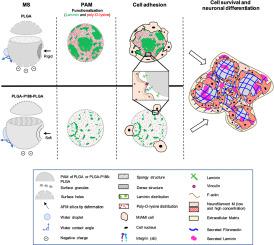Biomaterials Advances ( IF 7.9 ) Pub Date : 2021-01-06 , DOI: 10.1016/j.msec.2020.111852 Assia Rmaidi , Mischa Zelzer , Laurence Sindji , Raphaël Dima , Frank Boury , Nicolas Delorme , Claudia N. Montero-Menei

|
Polymeric, biodegradable, microspheres (MS) presenting a biomimetic surface of extracellular matrix (ECM) proteins are currently used for transporting cells and/or encapsulated proteins for regenerative medicine studies. They can be made of (lactic-co-glycolic acid) (PLGA) or of a more hydrophilic PLGA-P188 (Poloxamer188)-PLGA polymer allowing for the complete release of the therapeutic proteins. They promote stem cell adhesion, cell survival and differentiation after transplantation. Although the biological effectiveness of these microcarriers is established, a detailed understanding of the protein and cell interactions with the microcarrier surface remain unclear due to a lack of information of their surface properties. The aim of this study was to characterize the physicochemical properties of two polymeric MS systems and determine the effect of laminin and poly-d-lysine coated microcarriers on stem cell adhesion, survival and neuronal differentiation. The hydrophobicity and topography of PLGA MS promoted protein adsorption and the stem cells quickly adhered and spread on the surface of these microcarriers. In contrast less proteins adsorbed onto PLGA-P188-PLGA MS and although cells adhered to these microcarriers, they remained round and did not spread on their surface. Despite these early-stage differences, our results suggest that the nature of the MS does not strongly influence the long-term cell behavior. The cells exhibit the same cell number, differentiation profile and ability to secrete ECM molecules regardless of the type of microcarrier used. Likely the ECM molecules that form a microenvironment around both of these 3D microcarrier/cell constructs over time play a role in this converging cell behavior. We have thus furthered our understanding of the physicochemical properties of polymeric cell carriers affecting stem cell behavior to help tailor suitable microcarriers for neuroregenerative applications.
中文翻译:

细胞粘附分子功能化的聚合物微球的理化性质对间充质基质细胞行为的影响
具有胞外基质(ECM)蛋白质仿生表面的聚合物,可生物降解的微球(MS)目前用于运输细胞和/或封装的蛋白质,用于再生医学研究。它们可以由(lactic- co-乙醇酸(PLGA)或亲水性更高的PLGA-P188(Poloxamer188)-PLGA聚合物,可完全释放治疗性蛋白质。它们促进移植后的干细胞粘附,细胞存活和分化。尽管已经确立了这些微载体的生物学有效性,但是由于缺乏有关其表面性质的信息,因此对蛋白质和细胞与微载体表面相互作用的详细了解仍不清楚。本研究的目的是表征两种聚合物MS系统的物理化学性质,并确定层粘连蛋白和聚的效果d-赖氨酸包被的微载体对干细胞的粘附,存活和神经元分化的影响。PLGA MS的疏水性和形貌促进了蛋白质的吸附,干细胞迅速粘附并扩散在这些微载体的表面。相反,较少的蛋白质吸附到PLGA-P188-PLGA MS上,尽管细胞粘附在这些微载体上,但它们仍然是圆形的,并且不会在其表面扩散。尽管存在这些早期阶段的差异,但我们的结果表明MS的性质不会强烈影响长期细胞行为。无论使用哪种微载体,这些细胞均具有相同的细胞数,分化特征和分泌ECM分子的能力。随着时间的流逝,可能在这两个3D微载体/细胞构建体周围形成微环境的ECM分子在这种聚合细胞行为中发挥了作用。因此,我们进一步了解了影响干细胞行为的聚合细胞载体的理化性质,以帮助定制适合神经再生应用的微载体。


























 京公网安备 11010802027423号
京公网安备 11010802027423号